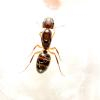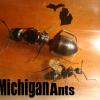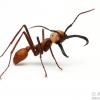After just shy of 4 months hibernation I took them out this was 5 days ago. A very large portion of the workers are dead. The queen seems to be okay though. I have another colony of the same species that went through the same hibernation and only 4 workers died, and they are all back to life now. They even moved into there new THA talus. Not sure what happened here I kept them hydrated, checked on them every 2 weeks or so. I'm a little sad. They are just piled up at the bottom. I've been watching them, I remember someone saying it can take up to a week or so for them to come back so well see.




















